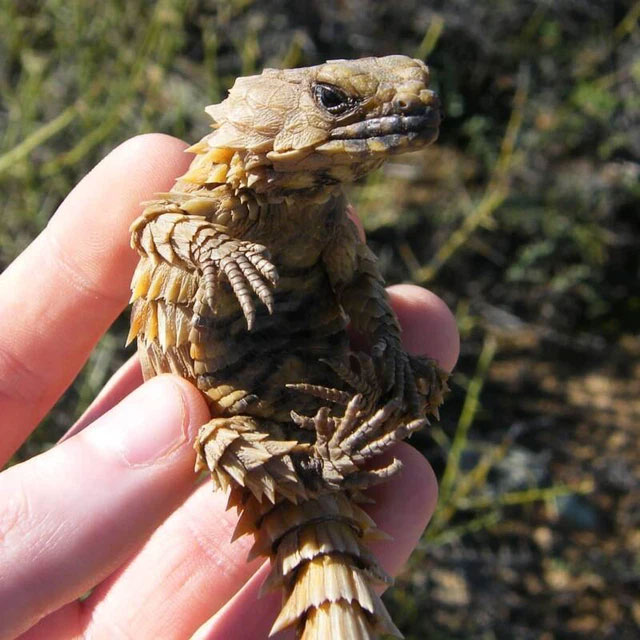Armadillo Lizard - Dragons in real life
One of the strangest animals in the rocky plains of South Africa, the armadillo lizard possesses a very distinctive appearance and is likened to a miniature dragon in real life.

Armadillo lizards live among the rock crevices of the Succulent Karoo region of South Africa and Namibia. Also known as golden armadillo lizards, these thorny reptiles can be dangerous, but they are slow-moving, shy, and will try to run away when approached by other creatures.
Found in the crevices of the Succulent Karoo, the armadillo lizard (Ouroborus cataphractus) is a creature that is both distinctive and endearing. This lizard is a small-sized reptile that ranges in color from brown to pale yellow. However, their most unique attribute is their spiky skin.

The armadillo lizard, scientifically known as Ouroborus cataphractus, is a small-sized reptile. Males and females grow to a maximum size of 4 inches.
Armadillo lizards are covered with sharp spines, except for the lower abdomen. This makes the lizard's underside vulnerable to predators, which is why this strange animal has developed an equally different form of defense: curling up into a the ball when threatened, reveals only the exterior resembling an armored
vehicle.

The body of this strange animal is covered with sharp spines, except for its lower abdomen.
Armadillo lizards will curl up when attacked by natural enemies such as birds, snakes, and mongooses. When needed, they can stay in this position for up to an hour.
Armadillo lizards are one of the few lizards that do not lay eggs and give birth to only one or two pups a year. Another feature of this strange creature is its general habitat. They are social animals and therefore prefer to live and protect each other in large groups.

When threatened, the armadillo protects its vulnerable lower body by curling up into a ball. They can use the curled position to quickly roll down the mountain, fleeing and disappearing. This way of escape is very similar to that of mammals called Armadillo, hence the name Armadillo lizard.
However, the biggest threat to this lizard is humans. The reptile's small size, distinct appearance and calm demeanor have made it a popular item in the pet market, especially on the black market, although the trade in this lizard considered illegal.

Their thick armor and special protection mechanisms resemble those of an armored vehicle.
According to Capetown, a wildlife trafficking group has been busted for illegally possessing and transporting 48 armadillo lizards. The criminals were sentenced to 1 million South African Rand ($70,000) or 13 years in prison.
In 2020, US Customs and Border Protection (CBP) officers discovered five armadillo lizards inside a stuffed animal at a border in Cincinnati, Ohio.

They usually eat small insects and invertebrates, but they especially like to eat termites. Termite nests can often be located far away from armadillo lizards, and sometimes armadillo lizards will need to travel distances up to more than 18 meters, a long way to travel for an animal of this size. . In captivity, people often feed them crickets.
Until the late 1990s, Ouroborus cataphractus was classified as a vulnerable population by the International Union for Conservation of Nature (IUCN).
Fortunately, however, this species has recently been downgraded from IUCN's "vulnerable" status to "least concern" due to more protective laws governing the possession of such species. This exotic animal as a pet.

Armadillo lizards are pregnant for a long time, usually 6 to 8 months, sometimes with some females that can take up to 1 year to reproduce.

The armadillo lizard is considered a social creature and will form community groups with up to 60 lizards at a time, sharing rock crevices in their natural habitat. In fact, it's very rare to see an armadillo lizard out in the wild alone.

This lizard has a very slow reproduction rate. They love to bask in the warmth of the sun and are one of the few reptiles that don't reproduce by laying eggs.

This type of lizard often lives in many rocky deserts, encountering raptors, hiding in the rocky crevices. They are mainly distributed in South Africa, averaging 7.5-9cm in size, and are light or dark brown in color. South Africa is an animal protection country, it is very difficult to legally import this species, sometimes only a few appear on the pet market, so the price is very high.

In captivity, this particular lizard can live from 8 to 10 years. Their pointed blades give them a dragon-like appearance, and they are relatively simple to care for compared to other reptiles. However, because they are social, when kept in captivity, it is common to keep several animals at a time so that they can be comfortable and not stressed.
- Why are Komodo dragons more 'short-lived' than males?
- Records of dragons 'real' in history
- The giant 'monster' swallowed the monkey in an instant
- There is a dragon that actually exists on Earth but has gone missing without anyone knowing
- Strange creatures are like sushi pieces, but don't touch ...
- Komodo dragon, prehistoric monster about to be extinct
- Electric cars can be miniaturized
- Video: 7 Komodo dragons rarely born in Indonesia
- Mysterious drama of Komodo dragon
- Tourists escape from Komodo dragons thanks to their quick wits
- Komodo dragons originate from Australia
- Komodo dragons use venom to kill prey
 Animal 'suffering' after hibernation
Animal 'suffering' after hibernation Why do goats climb well?
Why do goats climb well? Scientists were surprised to see chimpanzees eating turtles
Scientists were surprised to see chimpanzees eating turtles Giant catfish died deadly due to drought in Thailand
Giant catfish died deadly due to drought in Thailand